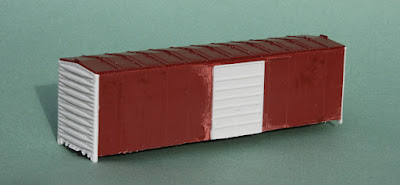I haven’t attempted to get very far into maintenance-of-way (MOW) cars for the Southern Pacific, because there is little scope for them on my layout. But I do find them interesting. By far the most common MOW car type in the transition era, which I model, was the boarding bunk car (and see this post: https://modelingthesp.blogspot.com/2023/11/small-project-sp-boarding-bunk-car-pt-2.html ). There were dozens and dozens and dozens of bunk cars, and scattered among them, for obvious reasons, were cars for feeding the men: dining cars, and commissary-kitchen cars. This post is about modeling a car like that.
Among model starting points, both Train Miniature and Tyco made plastic MOW cars back in the day, and Mantua and Walthers (inheritor of the Train Miniature line) have offered them also. Of course, for SP as for most railroads, there was considerable variety in the appearance of MOW cars in any category; these were cobbled into shape in the shops in whatever way worked.
So although good prototype photos are available, particularly in Ken Harrison’s superb book (Southern Pacific Maintenance of Way Equipment, SPH&TS, 2022), the sheer variety of prototypes means that even a commercial model isn’t too far from realism. It would challenge the memory of most of us to be certain that a pasrticular model wasn’t close to a prototype car.
Some years ago at a swap meet, I came across a Tyco MOW car, nicely modified with wire grab irons and so forth, but evidently mistreated over its life, and rather derelict. I bought it for a couple of dollars and began to study what I could do with it. It had had its vertical-wheel brake gear removed (a good idea) and some windows had been blocked, true of some prototype cars. My first step was to add a brass horizontal brake wheel on a brass wire staff, as you see below.
I also painted the broom and shovel (probably for the coal stove) with contrasting colors, to help them stand out, and I placed screen in the open window. There were no couplers on the car as I received it. I have also patched the car side (the white patch in this photo). Note also that the car should have a sill step below the side door.
You may note that this model represents a car that was converted from a double-sheathed box car. Cars of that type were not numerous on the SP, but large classes B-50-6 and B-50-9 did fit that description, and many kitchen-diner and commissary-kitchen cars were in fact converted from box cars of those classes. This is evident in the vital publication, the 1956 SPMW car roster published by the SPH&TS.
Next came lettering.Over the years, SP varied the lettering on its MOW cars, but after World War II became fairly settled. The bunk car photo below illustrates it (John Lawson photo, 1951, Wilbur C. Whittaker collection). The two “Danger” warnings, in English and Spanish, were located various places on the cars, often near the car door, and frequently arranged over-and-under, as here. The car number was always accompanied by a light weight value. Note at far end of the car there is a repack stencil, something rarely seen. The low car number has no significance, as SP repeatedly re-used MW car numbers over the years.
(This car is a former Class B-50-6 box car, converted to MW service in December 1942, and is a Boarding Bunk car, obviously different from the model I’m describing, but illustrating lettering.)
The car shown above is riding on Vulcan trucks, widely used by SP at one time. But MOW cars exhibited a very wide variety of trucks in the 1950s, from ancient arch-bar trucks, through T-section, Vulcan and Andrews trucks, to more modern cast-steel AAR trucks. I chose to use a pair of arch-bars that were in my “surplus trucks” parts drawer. They might be Train Miniature; not sure.
I used the new Owl Mountain decal set for MOW box cars, #1225W (W = white). The set contains very nice, clear “Danger” warnings. (For completeness, I will supply the text of these warnings: “As these cars are liable to be moved at any moment, all parties are warned against lounging or sleeping under or near them.”) The side door’s sill step has been added.
With lettering done, I needed to add couplers. The original Tyco trucks had a “Talgo” coupler attached to the truck bolster. In addition to preferring body-mounted couplers, I was discarding the trucks. So Kadee couplers in their own boxes were added.
The remaining task was to weather the car. I did this with my usual acrylic washes (for background and process description, see the “Reference pages” linked at the upper right corner of this post). These cars did get fairly dirty in service and were rarely repainted, so one can go to whatever length one wishes. We know from the SPH&TS-published MOW roster that this car, SPMW 2381, was converted to MOW service in 1942, so one could about weather as much as desired.
Here’s the other side of the car, from that shown above.It has an open door, all right if the car is spotted somewhere, though not okay when being moved. Hanging on the car side are what appears to be a mop and a washboard. Here too, screen has been placed in two of the windows.
This has been an interesting exercise, starting with someone else’s model work (adding of wire grab irons) and completely redoing the finish, along with adding steps, lettering, and weathering. I am happy to have this car as a change for the equipment usually spotted on my layout’s outfit track.
Tony Thompson

















































